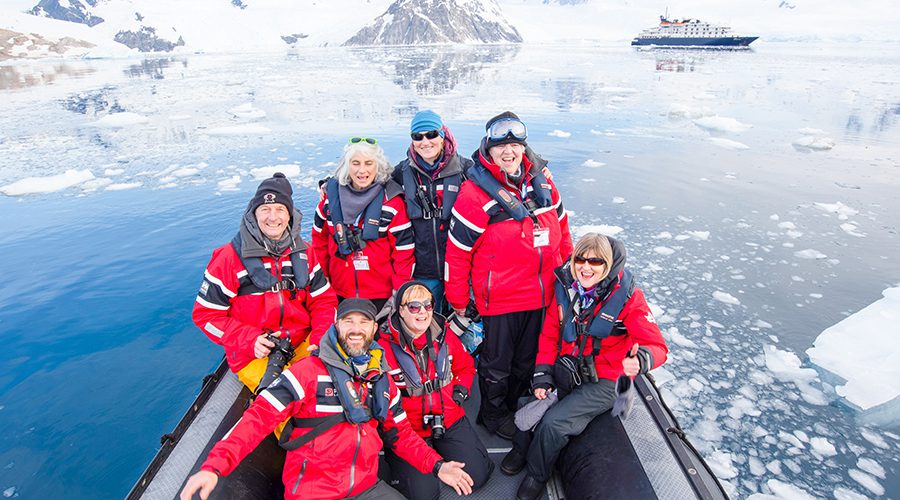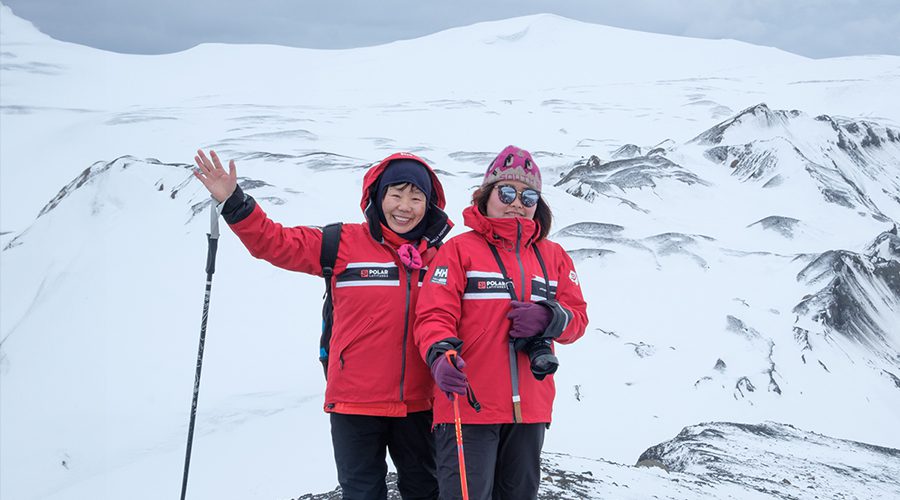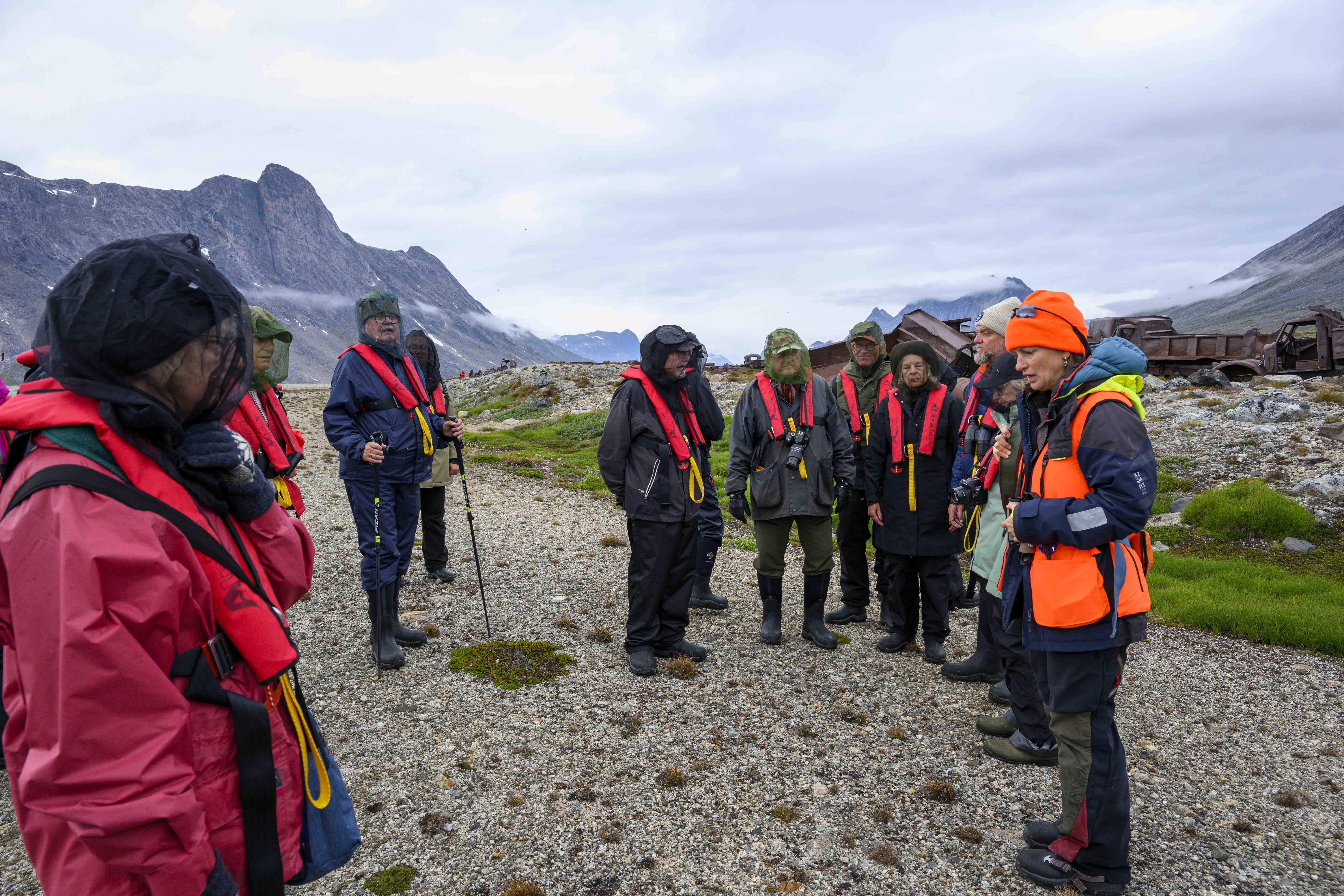Polar Gear – What to Pack
There’s No Such Thing As Bad Weather – Only Bad Clothing!
It’s never a good idea to take shortcuts when it comes to clothing – being improperly dressed can impact your enjoyment of the voyage! Wearing the right gear ensures that you stay warm and dry while exploring off the vessel. Onboard the ship, the dress code is always casual and informal – although feel free to dress up for the Captain’s Cocktail Parties!

Layers Are Your Friend
The best clothing is a layered system with an outer layer that is fully waterproof. The trapped air between the layers provides insulation.
- Base Layer – Thermal underwear and a pair of thermal socks (wool is ideal).
- Mid Layer – Pants (wool is ideal), a midweight fleece, and a wool sweater.
- Outer Layer – Waterproof pants* and a waterproof jacket that we provide, plus a hat and gloves. Sun protection (sunglasses, sunscreen, SPF lip balm) is also an important part of your outer layer!
Waterproof pants (not provided) are required to participate in all activities off the ship. - Footwear – Sturdy walking shoes or sneakers with good grip are ideal for the outer decks. We provide you with rubber boots for landings. Please note that for safety reasons, open-toed shoes may not be worn onboard.
*Note: Lightweight disposable rain gear will not endure more than one landing, so please bring high quality, expedition-weight waterproof pants. Remember that ‘water resistant’ clothing is not suitable.

A Professional-Grade Expedition Jacket
Our time-tested expedition jackets, yours to use throughout the trip, are custom-designed with the polar regions in mind. They’re lightweight, waterproof, and wind-resistant. They hug the body, are both warm and breathable, and feature a high collar and generous overall length that will keep the chill and sea mist and spray from ever sneaking up on you. We added plenty of sturdy loops to secure gloves, a water bottle, or a GoPro, ensuring that nothing goes overboard. Waterproof inside pockets will keep your personal items dry and safe at all times.

From Pole to Pole
The Arctic and Antarctic are both cold: but that is more or less all they have in common! Preparing for a voyage to each therefore requires slightly different equipment.
Some differences you may wish to consider while packing for your polar expedition:
- The Antarctic is generally colder than the Arctic, so you may want to add an extra layer.
- Unlike in the Antarctic, bugs can be a nuisance in the Arctic, especially in mainland Norway and Greenland! You may wish to pack a head net.
- In the Arctic, the areas we land on are largely snow and ice-free, with more opportunities for hiking. We recommend to bring sturdy waterproof hiking boots with good ankle support – remember to wear them in first!
- If you are a fast walker, remember that you may get hot hiking – loose comfy hiking clothing is ideal.
- Remember to bring swimwear – not only do we have our luxurious hot tubs onboard, but you will need it for the Polar Plunge!
Need Gear?
We’re happy to suggest New Headings LLC for your expedition clothing needs. New Headings is a trusted, long-time supplier of quality polar gear, and offers a wide variety of polar gear for purchase, and a few select items for rent.
Please ensure that you read through the shop’s terms for picking up and returning rental items, and consider your plans for embarkation and disembarkation days.
Rentals are available only on voyages which embark and disembark in Ushuaia.
Suggested Packing List
Clothing
- Boots – provided by Polar Latitudes Expeditions
- Boot liners or insoles (optional) – to make your boots fit more comfortably
- Waterproof jacket – provided by Polar Latitudes Expeditions
- Waterproof pants (NOT water-resistant – required to participate in landings)
- Heavyweight fleece jacket or wool sweater to layer under your waterproof jacket
- Thermal top and bottom baselayers (at least two sets)
- Thermal socks (three pairs) in different thicknesses
- Warm hats that cover your ears (two, in case you get one wet)
- Cap with visor for sunny days – make sure it can be worn under your warm hat
- Waterproof winter gloves or mittens (two pairs, to rotate when wet)
- Glove liners (great for taking photos)
- Hiking trousers, khakis, fleece or other pants (several pairs), to layer under your waterproof pants on excursions, and for around the ship or ashore in town
- Shirts and other loose-fitting hiking clothing
- Walking shoes or hiking boots
Other Essentials
- Sunglasses (polarized, close-fitting are best) or ski goggles (optional; can help protect eyes in windy conditions)
- Sunblock and SPF lip balm
- Daypack or backpack (roll-top waterproof-style is best; or line with plastic bags)
- Water bottle
- Bathing suit (optional – to use in the hot tubs or for the polar plunge!)
- Binoculars
- Strap to secure your cell phone
- Camera, extra batteries (and charger), and memory cards
- Plastic freezer bags with zip closures (useful for keeping your camera and other small items dry)
- Converters/adapters as required for your devices
- Appropriate clothing for transit destinations
- Medications – bring a sufficient supply of any medications you regularly take, whether prescription or over-the-counter, as well as copies of your prescriptions
- Spare prescription glasses or contact lenses, if you wear them
- Seasickness medication, if you are prone
